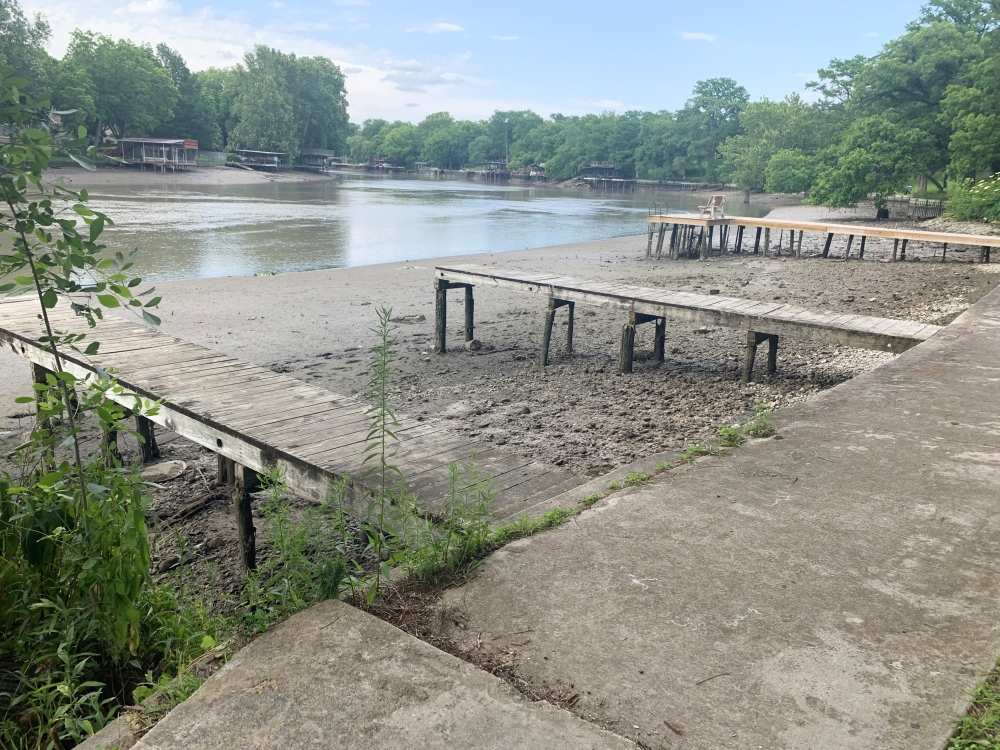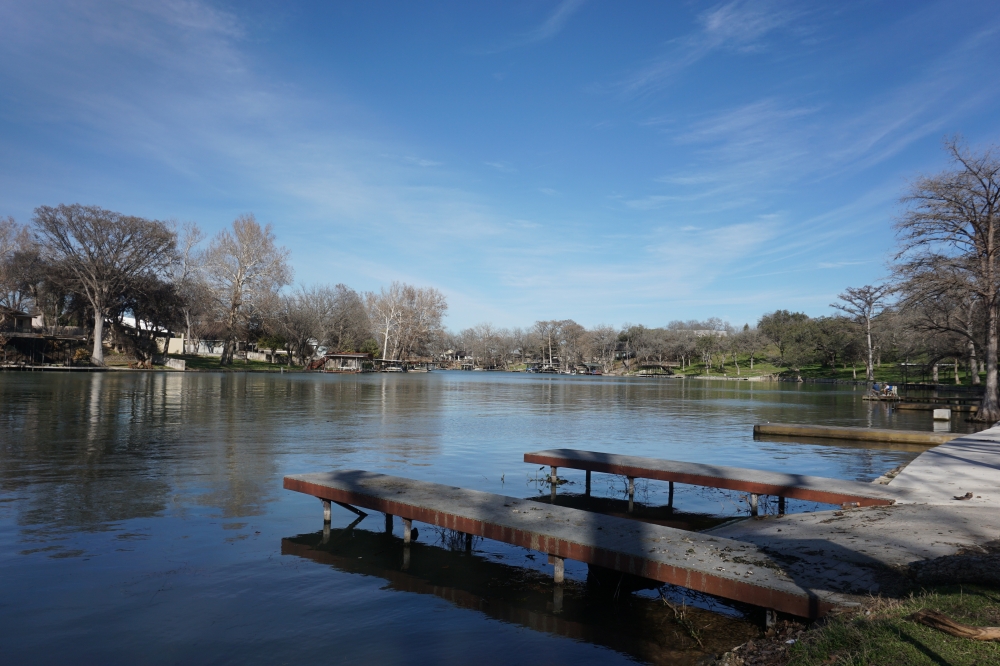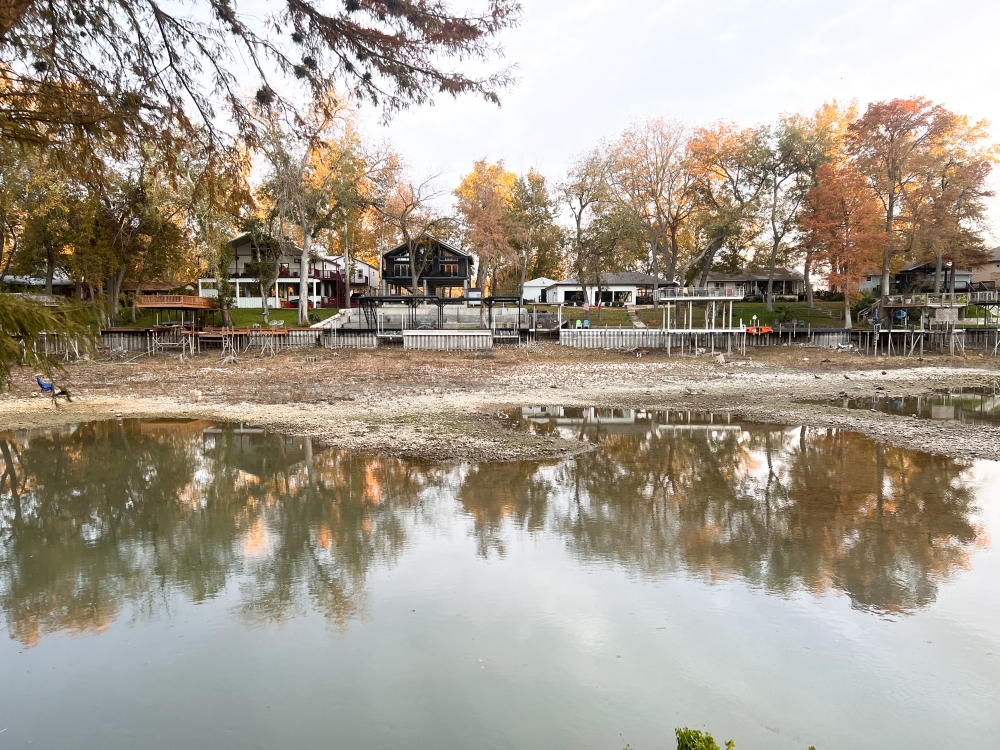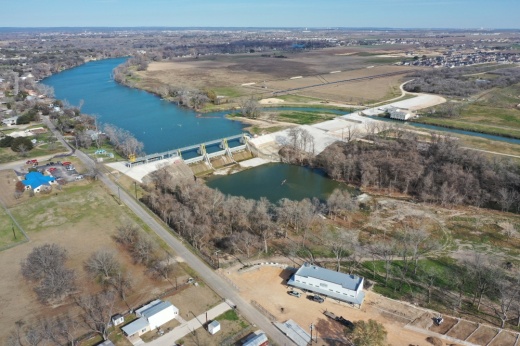While residents above the dam are enjoying activity again on the lake, those below the dam are facing a new reality.
A 2-mile stretch of the Guadalupe River below the dam is now barely flowing, as the new dam allows passage of much less water, causing concern for those used to a more robust river.
Two-minute impact
Lake Dunlap consists of a 9-mile, 410-acre stretch of the Guadalupe River east of I-35 in New Braunfels. It is one of six dams operated by the Guadalupe-Blanco River Authority along the Guadalupe River.
After the dam breached one of its spill gates, draining the lake in May 2019, residents along the lake formed a Water Control and Improvement District—along with the help of elected officials—to tax themselves in order to come up with some of the funding to rebuild the dam.
Construction of the dam was completed in 2023 and lake levels returned to normal by the end of the year. However, the new dam has not returned the river to the state it was in under the previous construction. Because of the lower levels down river, residents below the dam are asking if it is permissible to cut off river flow so drastically.
“This stretch of river is devastating. It’s horrible,” said Tim White, who owns land immediately below the dam. “I got cypress trees down there that are three feet out of water,” White said.
How we got here
Securing resources and backing from stakeholders for the Lake Dunlap dam project took two years from the dam failing in 2019 to construction breaking ground.
1928
- Construction of dam is completed
- One of three spill gates fails and mostly drains Lake Dunlap

Most boat docks along the lake were dried up as seen in this May 2019 file photo. (Rachal Elliott/Community Impact)
- The Texas Commission on Environmental Quality approves the creation of the Water Control and Improvement District
- Financing and operation agreement is reached between Lake Dunlap WCID and the Guadalupe-Blanco River Authority should the district receive voter approval for the WCID to form
- Voters approve creation of Lake Dunlap WCID, tax rate and up to $40 million in bonds
- GBRA secures $40 million in bond funding for dam through the Texas Water Development Board’s state revolving fund
- Construction begins to rebuild Lake Dunlap dam
- Zachry Construction begins installing the first of three Hydraulic Crest Gates of the dam
- Lake Dunlap is virtually back to its historic levels

By October 2023 the lake was fully refilled to pre-dam collapse levels. (Sierra Martin/Community Impact)
The new Lake Dunlap dam is more efficient at directing water through the hydroelectric generating facility than the old dam, Dunlap WCID President Doug Harrison said.
“More water goes down the canal, and less water leaks past the dam,” he said.
The canal water channel returns to the river at the hydroelectric generation house.
“The Dunlap facility has absolutely no impact on flow rates or volumes in [Lake] McQueeney or any other lakes,” he said.
Water flow over the past nearly five years was unusually high due to the dam’s failure, according to GBRA.
The dam is permitted under a Texas Commission on Environmental Quality permit dating back to 1914, said Lindsay Campbell, a spokesperson for GBRA, in an email.
“That authorizes how and when water is to be conveyed through the canal and powerhouse at Lake Dunlap. With the successful rehabilitation of Lake Dunlap, normal operations have resumed consistent with this permit,” Campbell said.
According to Zachry Construction, the company that rebuilt the dam, the new dam was built upon the two old spill gates left standing, and an additional 15-foot width of new concrete was added. That gave White reason to question why a new environmental permit wasn’t deemed necessary when the new dam differs in design than the older dam.
Due to stagnating water, fish are stuck in small pools and ponds just below the dam, inviting birds to gather and eat them, White said.
“It’s great to see the birds. But the birds are eating dead clams and fish. It’s like a smorgasbord for them because the fish have nowhere to go,” White said.
What they’re saying
- “For my whole life, we had pretty decent flow ... it’s pretty upsetting to go from having a river to not having a river.“ Phillip Schulze, landowner below the dam
- “Lake Dunlap is back! Waterfront property owners and visitors are able to use the lake as it has been for 100 years.” Doug Harrison, president, Lake Dunlap WCID

One more thing
According to Victoria Cann, a spokesperson for TCEQ, the water rights for Lake Dunlap authorize diversion but do not require that a specific volume of water pass downstream of the dam.
That assertion has not stopped locals from challenging the new dam’s operations.
They contend no entity should be able to cut the water flow that significantly and are seeking out any state entity or other actor that will hear their case to address the issue.
“Our argument is, you can’t eliminate a stretch of river that’s been there since the dawn of time,” White said.





